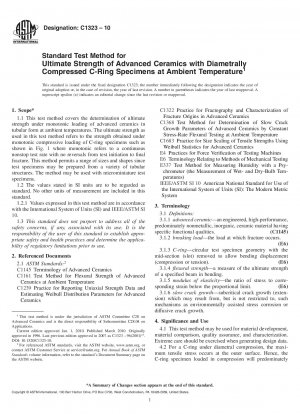ASTM C1323-10
Standard Test Method for Ultimate Strength of Advanced Ceramics with Diametrally Compressed C-Ring Specimens at Ambient Temperature
- Standard No.
- ASTM C1323-10
- Release Date
- 2010
- Published By
- American Society for Testing and Materials (ASTM)
- Status
- Replace By
- ASTM C1323-16
- Latest
- ASTM C1323-22
- Scope
This test method may be used for material development, material comparison, quality assurance, and characterization. Extreme care should be exercised when generating design data.
For a C-ring under diametral compression, the maximum tensile stress occurs at the outer surface. Hence, the C-ring specimen loaded in compression will predominately evaluate the strength distribution and flaw population(s) on the external surface of a tubular component. Accordingly, the condition of the inner surface may be of lesser consequence in specimen preparation and testing.
Note 18212;A C-ring in tension or an O-ring in compression may be used to evaluate the internal surface.
The flexure stress is computed based on simple curved-beam theory (1, 2, 3, 4, 5). It is assumed that the material is isotropic and homogeneous, the moduli of elasticity are identical in compression or tension, and the material is linearly elastic. These homogeneity and isotropy assumptions preclude the use of this standard for continuous fiber reinforced composites. Average grain size(s) should be no greater than one fiftieth (1/50) of the C-ring thickness. The simple curved-beam theory stress solution is in good agreement (typically better than 1%) with a theory of elasticity solution as discussed in (3) for the geometries chosen for this standard. The simple beam theory stress equations are relatively simple. They are relatively easy to integrate for Weibull effective volume or effective area computations as shown in Appendix X1.
The simple curved beam and theory of elasticity stress solutions both are two-dimensional plane stress solutions. They do not account for stresses in the axial (parallel to b) direction, or variations in the circumferential (hoop, σθ) stresses through the width (b) of the test piece. The variations in the circumferential stresses increase with increases in width (b) and ring thickness (t). The variations can be substantial (> 10 %) for test specimens with large b. The circumferential stresses peak at the outer edges. Therefore, the width (b) and thickness (t) of the specimens permitted in this test method are limited so that axial stresses are negligible (see Ref. 5) and the variations of the circumferential stresses from the nominal simple curved beam theory stress calculations are typically less than 4 %. See Ref. (3) and (4) for more information on the variation of the circumferential stresses as a function of ring thickness (t) and ring width (b).
The test piece outer rim corners are vulnerable to edge damage, another reason to minimize the differences in the circumferential stresses across the ring outer surface.
Other geometry C–ring test specimens may be tested, but comprehensive finite element analyses shall be performed to obtain accurate stress distributions. If strengths are to be scaled (converted) to strengths of other sizes or geometries, then Weibull effective volumes or areas shall be computed using the results of the finite element analyses.
Because advanced ceramics exhibiting brittle behavior generally fracture catastrophically from a single dominant flaw for a particular tensile stress field, the surface area and volume of material subjected to tensile stresses is a significant factor in determining the ultimate strength. Moreover, because of the statistical distribution of the flaw population(s) in advanced ceramics exhibiting brittle behavior, a sufficient n..........
ASTM C1323-10 Referenced Document
- ASTM C1145 Standard Terminology of Advanced Ceramics
- ASTM C1161 Standard Test Method for Flexural Strength of Advanced Ceramics at Ambient Temperature
- ASTM C1239 Standard Practice for Reporting Uniaxial Strength Data and Estimating Weibull Distribution Parameters for Advanced Ceramics
- ASTM C1322 Standard Practice for Fractography and Characterization of Fracture Origins in Advanced Ceramics
- ASTM C1368 Standard Test Method for Determination of Slow Crack Growth Parameters of Advanced Ceramics by Constant Stress Rate Strength Testing at Ambient Temperature
- ASTM C1683 Standard Practice for Size Scaling of Tensile Strengths Using Weibull Statistics for Advanced Ceramics
- ASTM E337 Standard Test Method for Measuring Humidity with a Psychrometer (the Measurement of Wet- and Dry-Bulb Temperatures)
- ASTM E4 Standard Practices for Force Verification of Testing Machines
- ASTM E6 Standard Terminology Relating to Methods of Mechanical Testing
- IEEE/ASTM SI 10 American National Standard for Metric Practice
ASTM C1323-10 history
- 2022 ASTM C1323-22 Standard Test Method for Ultimate Strength of Advanced Ceramics with Diametrally Compressed C-Ring Specimens at Ambient Temperature
- 2016 ASTM C1323-16 Standard Test Method for Ultimate Strength of Advanced Ceramics with Diametrally Compressed C-Ring Specimens at Ambient Temperature
- 2010 ASTM C1323-10 Standard Test Method for Ultimate Strength of Advanced Ceramics with Diametrally Compressed C-Ring Specimens at Ambient Temperature
- 1996 ASTM C1323-96(2001)e1 Standard Test Method for Ultimate Strength of Advanced Ceramics with Diametrally Compressed C-Ring Specimens at Ambient Temperature
- 1996 ASTM C1323-96(2001) Standard Test Method for Ultimate Strength of Advanced Ceramics with Diametrally Compressed C-Ring Specimens at Ambient Temperature
- 2001 ASTM C1323-96 Standard Test Method for Ultimate Strength of Advanced Ceramics with Diametrally Compressed C-Ring Specimens at Ambient Temperature
